As regular followers know, my family lives on a 129-acre farm in Ontario. You also know that I’m a big proponent of off-leash time for dogs, so this post is all about how to train a dog to stay on your property.
Note this this post is mostly relevant to people with larger properties as opposed to typical neighbourhood yards, but some of the info applies to both situations.
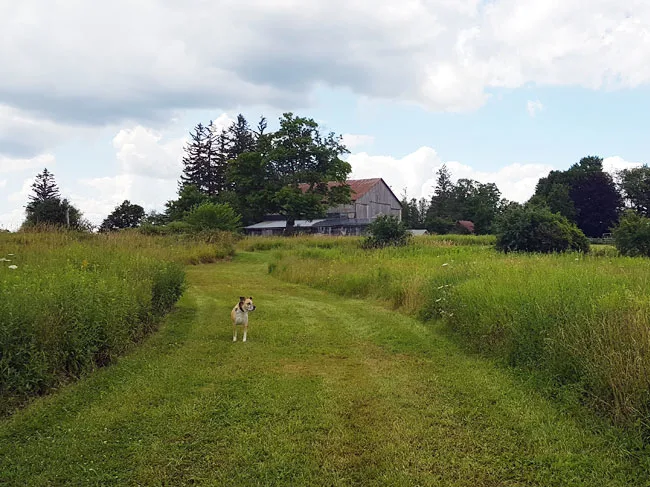
As I’m writing about training a dog to stay on my property, I’m thinking about my pet dog, Baxter. Livestock guardian dogs or true working farm dogs are a different scenario (which I will touch on below). This article focuses mostly on my experience with training a pet dog to stay in the yard.
Training your dog to stay in the yard by using a leash
When we first adopted Baxter, we kept him on leash any time he was outside. Whether you have a puppy or an older dog, it takes some times to get to know each other, build your bond and establish boundaries.
The leash is the best tool to build a strong foundation for the behaviour you want from your dog.
If we were working outside, we brought Baxter with us. Whatever chore we were doing, he was there.
We used a long line so he could move around if he wanted to, and we clipped him up wherever we were. By the house if we were gardening (which for us includes lighting things on fire), behind the barn if we were mowing, or even to a tree if we were in the back woods.
We made sure he had access to shade and water.
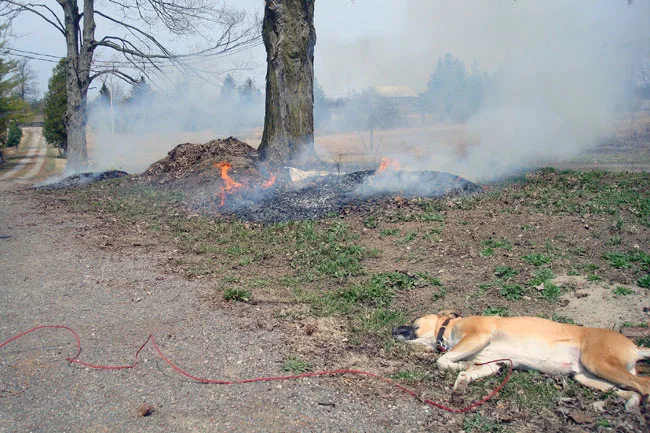
Keeping Baxter with us helped us bond and also taught him patience. He would quietly lay on the ground and watch what was going on around him.
To train our dog to stay on our property, we also did a lot of on-leash walks around our land. Again, we would often use the long line, so that he had a fair amount of freedom.
He got to know the trails and the fields and where he could and could not go. If he tried to venture into the woods, I said, “far enough” or “with me.” That was usually enough to get his attention and bring him back to me.
Work with your dog on coming when called
If you want to train your dog to stay in the yard, a strong recall is going to be your best tool.
Your dog may decide to go for a wander. He may smell something interesting. Or he may see another animal and decide to chase it. On our property, Baxter has chased coyotes, deer, wild turkey, turkey vultures, squirrels, rabbits, chipmunks and our barn cat.
A strong recall ensures you will be able to get your dog to come to you, and prevent you from chasing your dog all over the countryside.
If you need a refresher, here is our post on how to teach a dog to come when called.
You should practice recall in a calm environment with few distractions and slowly build up to more challenging scenarios. Use high-value treats or a long leash to encourage your dog to come when called.
See my post: Off-leash hiking with your dog
Slowly build up to off-leash training in the yard
When you feel your dog is ready to be off-leash in the yard, start slowly.
Think about the scenarios where you feel most confident in your dog’s ability to stay within the boundaries you’ve set.
For us, we started having Baxter off-leash while we were working in the gardens. We were near the house in “civilized” territory, he was used to laying on the lawn while we worked, and we could keep an eye on him.
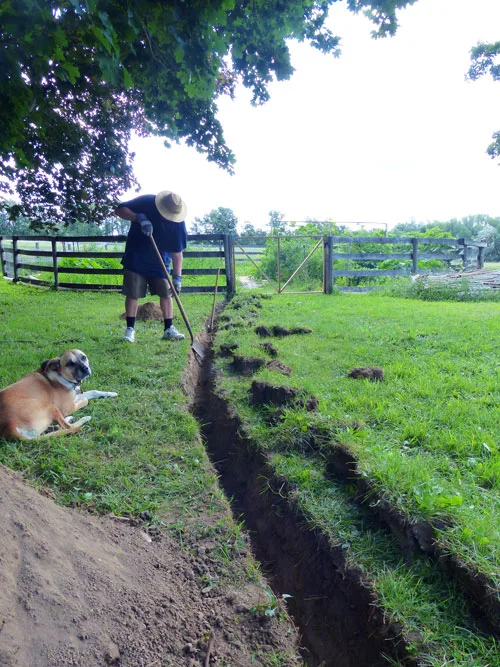
How can I keep my dog in the yard?
Even with Baxter off leash, we kept a leash with us, so that if he did get distracted or take off, we could chase him down and bring him back easily. And if he did run away, there were consequences. Usually, we put him in the house and he didn’t get to stay outside with us any longer.
It took a bit longer for us to build up our confidence to go for walks off leash on our property. And even longer to venture into the trails through our forest without a leash. But we got there.
However, even after living with us for 6 years, Baxter is not always off leash. Depending on his attitude, the weather or the wildlife, we will clip him up if we feel we need to.
How to keep your dog from running off
We live in coyote territory, but usually they stay hidden in the woods. Earlier this year, Baxter ventured into the woods on his own and had an encounter with what we assume was a coyote.
We then saw a coyote pretty regularly for a few weeks. We kept Baxter on leash for a few months until we were safely through the pup-raising period. Things seem to have returned to normal, and Baxter now has off-leash privileges again.
Don’t leave your dog unattended in the yard
Baxter does not go off-leash on his own. There are lots of times (especially in the nice weather) where he asks to go outside.
In those scenarios, we use our long leash and clip him to a tree. He can sunbathe as much as he wants, move into the shade when he’s too hot, get a drink if he needs to, but we know he’s safe and secure because he’s tied up.
When we come outside with him, we unclip him and he has free range.
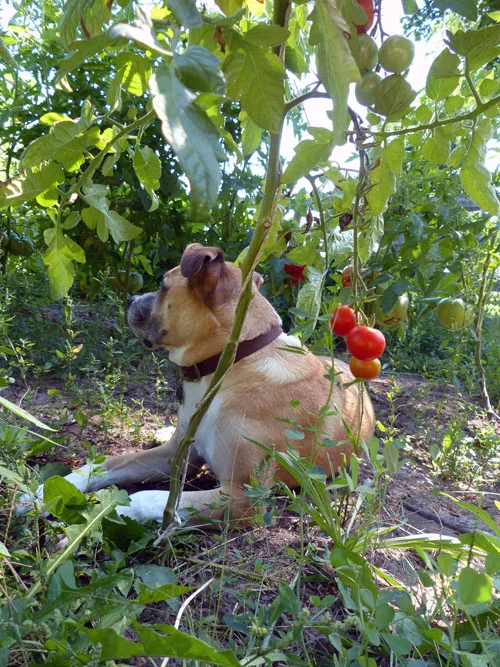
Even though we’re outside together, we’re not always watching him. But, we’re close enough that we can check on him every so often and make sure he’s still with us. Also, he knows we’re there and thanks to the time that we spent building our bond, that’s usually enough to keep him nearby.
Know your dog and what will help him stay in the yard
A dog’s breed and personality are often the main factors that determine whether he might wander. Understanding your dog can help you train your dog to stay on your property.
If your dog is part hound, he may like to follow his nose. Watch your dog, and be prepared to get his attention if he seems to be sniffing intently.
If your dog has a high prey drive, he may chase an animal that crosses his path. Know the wildlife that is around your property and work on recall.
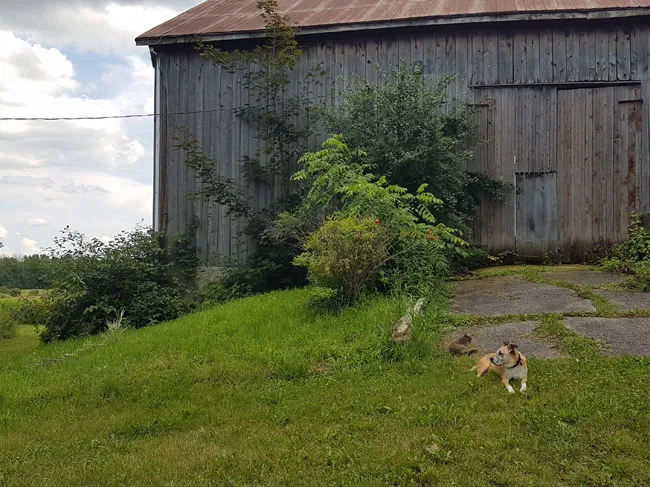
How to boundary train your dog
If your dog is independent or over-confident (Baxter), he may try to stretch his boundaries and wander off. To train your dog to stay on your property, make sure to spend time on leash to teach your dog what the physical limits are.
Knowing your dog’s tendencies and being thoughtful about when your dog is permitted to be off-leash can help your dog to be successful at staying within the boundaries you set.
Training livestock guardian dogs to stay on your property
As I mentioned at the start of this article, livestock guardian dogs are very different from pet dogs.
These dogs are bred to take care of animals, defend against predators and oversee a farm. They typically live outside with the livestock untethered 24/7 and do their duties unsupervised.
A few months ago, I wrote about livestock guardian dogs, and April Mantle of 3 Birch Farm shared her experience with her two Maremma dogs. Here’s what she had to say about training her livestock guardian dogs to stay on her property.
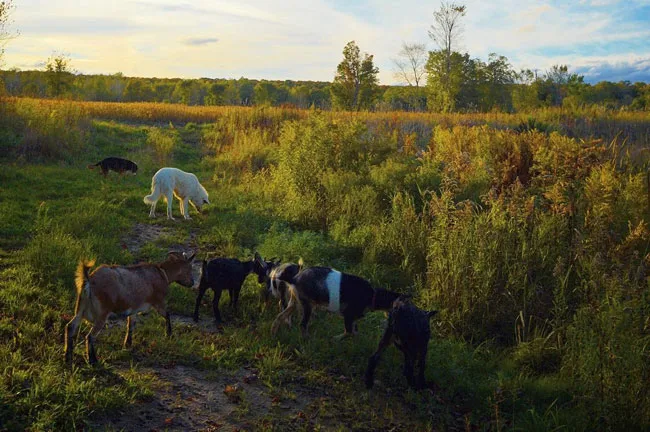
How to stop livestock guardian dogs from wandering
April noted that wandering is a large problem with livestock guardian dogs. Some dogs may never wander, some may follow their stock if they break out, or others may roam in an attempt to expand their territory or look for intruders.
She describes one of her dogs as a scout dog. “She likes to check fence lines, patrol, and check for places where a predator could potentially get in. In her younger years she was always finding ways out of the fence and would actively walk the fence and push on it to find any weak points.”
April also notes that unfixed working dogs may be more prone to wandering, as their hormones can distract them. The tendency to wander depends also on a dog’s breed and individual personality.
“The best solution… is to have good fences and a strand or two of electric fence as an enforcement,” says April. (Normally at the bottom to discourage digging and the top to stop them from jumping.)
Consider a fence to keep your dog in the yard
One way to give your dog off-leash freedom while keeping him safe and close to home is a fence. While it may be unrealistic or challenging to fence acres and acres of property, you can enclose a yard—even a large yard—for your dog within your property.
Training your dog to stay in the yard with a shock collar
If a literal physical fence isn’t an option for your property, an electric fence that’s linked to a sensor on your dog’s collar (as opposed to the literal electric fence that April recommends) can be a good option.
E-collar training for dog to stay in the yard
You can also use an e-collar (electronic collar) with a handheld remote to train your dog to stay in the yard even if you don’t have an electronic fence. With an e-collar and remote, you control the timing and the type of “correction” your dog receives ranging from tone to vibration to static correction.
If you’re using an e-collar to train your dog to stay in the yard, it’s important to use something such as temporary flags to mark the property line. That way your dog has a visual.
Electronic fence companies such as Invisible Fence typically use small white flags to mark the boundary initially, so we assume dogs can see white flags pretty easily.
Lindsay uses a GPS and training collar with her weimaraner Remy for hiking off leash. She hardly ever has to give a static correction on the collar. Instead, she taught him that he gets a treat if he comes to her at the sound of the “beep” on the collar. He thinks this is a fun game!
Crops or bushes as boundaries in the yard
I’ve also found that mowed trails or the tall crops in the fields can function as barriers.
Admittedly, hay or soybeans (or whatever’s growing in your fields) are completely permeable, and if your dog wants to explore, he will push through. However, often animals take the easier path and the visual difference in terrain can help to enforce the boundaries that you set.
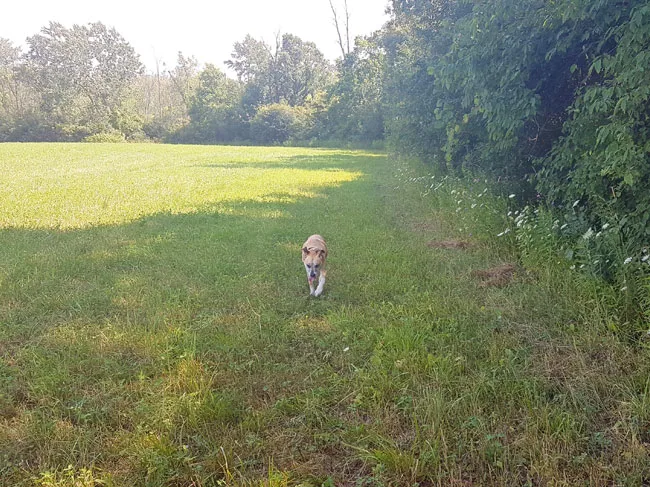
Safety for dogs in the yard
For any dog who is spending a lot of time outside, especially when your dog is off leash, there are a few precautions you should always take to keep him safe.
Make sure your dog has access to shelter and water. Sun, rain, snow and dehydration can all be hazardous for dogs. A dog house, awning, barn or shed that your dog can access when he wants will help to prevent dangerous situations. As well, a bowl of fresh water—make sure to freshen it every day—is essential.
What to do if your dog runs off
Despite all of your work to train your dog to stay on your property, there may be a time when he goes adventuring. Make sure that he can be identified as your dog.
A collar and tags with your contact information is the first step. A microchip is also important in case your dog loses his collar (also most livestock guardian dogs work without collars).
See our post: What to do if your dog runs away
Relax when you train a dog to stay on your property
Allowing your dog to be off leash requires a lot of trust. It also requires you to not panic if your dog goes exploring.
Remember all of the times you’ve spent walking or working with your dog in various parts of your property. This is all his territory now, so he may go check it out.
Hopefully, all of your training and preparation ensure that your dog knows where his home is and he has a strong bond with you. So even if he chooses his own adventure, he is trained to stay on your property within the boundaries you’ve set.
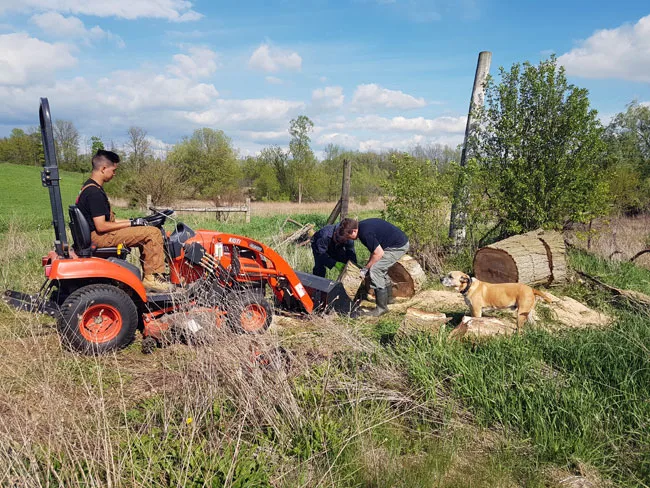
Over the years, we’ve built a lot of trust with Baxter, and him with us. We know he will occasionally chase the turkey vultures that fly over the farm—but he won’t go far (and never off property). He’ll quickly come back to the house. We also know that he knows where home is and wants to be here with us.
Train your dog to stay in other people’s yards
These behaviours do not extend off our property. I frequently bring Bax to my Mom’s house, which is in a more typical neighbourhood with small, unfenced lots.
There Baxter has no concept of boundaries. He’ll go visit the neighbours, watch out for the local cats and lay on the lawn next door. We still allow him to be off leash most of the time, but I’m especially vigilant to make sure he doesn’t trespass too much.
We’ve worked hard to build our bond and establish boundaries with Bax. It’s paid off with lots of time together and lots of freedom.
How do you spend time outside with your dog? How have you taught your dog boundaries?
Let us know in the comments!
Julia Thomson is a blogger at Home on 129 Acres where she writes about her adventures of country living and DIY renovating. She and her family live on a 129-acre farm in Ontario, Canada.

Heidi
Monday 7th of June 2021
My dog KNOWS she's supposed to stay on the property, she knows the boundaries, but she doesn't stay home. Any training suggestions for that
Tamara
Monday 9th of January 2023
@Heidi, I have the same issue. We have walked the property line of our 18 acres 100 times. Our Akbash still wonders and takes off on adventures with his chocolate lab accomplice in tow. Have you found any helpful advice? Oh- we also have the collars for both which are effective if we notice them before it’s too late. We then beep them to return and they come running, at which time they are rewarded for listening. other times they go too far and the collars are out of range…
maria soares
Tuesday 23rd of February 2021
we are currently living in a farm and my dogs keep wondering off, we have a fence but the wild boars dug holes in them so they escape through the holes. So at first we put gps trackers on them so we always new where they were, but they kept wondering out and we couldn't keep running after them, so we built a smaller fence (like a kennel but out doors with a dog house) and sometimes we would take for walks with us but they kept running away. But it got even more complicated, my estrela mountain dog attacked a dog and we couldn't take her on walks anymore and my golden retriever kept running away so we decided to try an electric collar that we borrowed from a friend and it worked in our friend's place but in the farm he went anyways besides I hate even the thought of hurting him.
maria soares
Tuesday 23rd of February 2021
@maria soares, what can I do?
Joanne
Saturday 28th of November 2020
We adopted a 2-3 year old large dog in August. We live on a large property in the country and Magnus has stayed home nicely all summer. Winter hit and he decided to roam the countryside, visit neighbors and steal dog food bowls and is barely home. Is there hope to train older dogs with a roaming desire with the methods you have outlined?
Lindsay Stordahl
Sunday 29th of November 2020
I think there is hope if you go back to the basics outlined here, which would mean you wouldn't leave him unattended in the yard for quite some time. I'm sorry to hear he's been wandering but I hope you can make some progress with him.
Susan
Monday 26th of October 2020
I have a 1-year old Australian Shepherd who’s been terrific about staying at home off leash. I’ve walked her around the boundaries of the farm (120) lots Of times. We could leave her out on her own and she would just lie near by or prowl around the yard, then we got new neighbours, with a dog. We were inattentive one day, and our Aggie went over to “meet” her new neighbour. Now every time I open the door she’s over there like a shot to play. Their dog is tied out most of the time and calls to Aggie And off she goes. There are no fences, just an open 5 acre field between our place and theirs. Any suggestions? I’d love to have her just hang out with us when we go to the barn or are in the field with the livestock, but now I can’t trust her!
Wendy M
Saturday 19th of September 2020
Our 6 month old (we’ve had them since 2 months of age) female St Bernard’s we had leash boundary trained for 3 months. Up until now they have remained on the farm property, but since the crop has been harvested next to the yard this week they have been caught wandering outside the yard. A concern as we live on a busy gravel road. They do come when called, we leash them and bring them home, without attention or happy to see them chatter. They have been spayed. Any advice?
Julia P.
Tuesday 29th of September 2020
I might try keeping them tied up for a little while. Get a long tieout so they still have a fair amount of freedom. A mown field is a big change, and they have a longer view now. The physical boundaries of the crop are not there as a barrier anymore. Once the novelty wears off, they may revert to their previous behaviour. You might also try walking them on lead around the border of your yard, not going into the field. That might help to enforce the border for them.